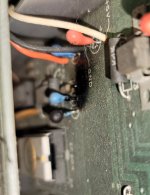It kind of makes me nervous about all my machines. More the risk of fire than anything else.
Changing them all out entails it's own risks to the machine.. damage to pads and traces, getting something backwards by accident.. etc.
It is more of a smoke & a stink out the room risk, than a fire risk.
If I replace the old blue Tants, I tend to replace them with modern Tants. The reason the Tans were used in the first place, over Electrolytic Caps, is that they have a much lower ESR, so good for putting on the inputs & outputs of the common garden linear voltage regulators, like the 7805.
Speaking of these, I would like to point out that the linear voltage regulators, like the 7805, the 7812 and their negative regulator cousins, are much more special than most people think.
There is a tendency for modern designers to accuse them of being inefficient, wasting energy as heat, and better replaced by more modern units which use a switching methodology.
But you might want to consider the notion of efficiency; It could be describes as; (wanted form of energy out / energy in) x 100 %. But here is the odd thing, if the energy out you wanted from an electrical appliance was just heat (the typical domestic Bar Heater), it would then be almost 100% efficient except for the red glow. I'm am not against heat production, within reason, if you can gain other benefits.
The genius of the design of the 7805 regulator, and their analog cousins, is the protection from over current and over temperature. They go into a safe thermal shut down mode. So if your Tant caps on the output side at least short out, it is no drama and nothing gets damaged.
Unfortunately most of the supposed better switching regulator replacements don't have this Thermal and over-Current protection.
I would rather have something labelled as inefficient, that was better & safer. Also the linear regulators have much lower noise than the switching ones. They do have interesting noise though. If you want to hear it, you simply couple the regulator's output, via a capacitor into the Phono input of your Stereo amplifier, it sounds a lot like White Niose. It is normal. I discovered this way back in the 1970's working with Audiometers.

